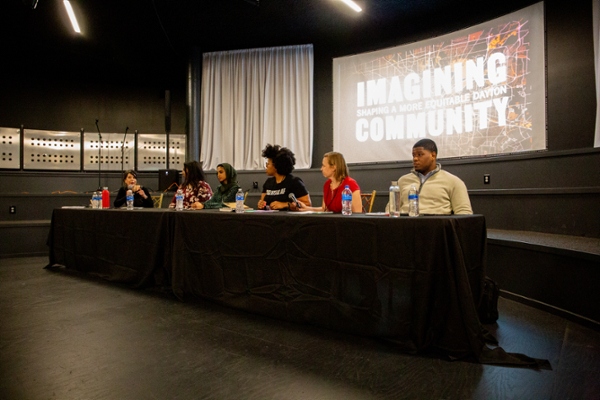News

Imagining Community symposium continues discussion on housing justice
After hosting a series of events last year exploring the impact of redlining in the Dayton region, University of Dayton faculty, staff and students will continue the conversation on housing justice during the second Imagining Community symposium Feb. 16-18.
Imagining Community: Housing Justice and Flourishing Neighborhoods will feature art exhibits, workshops, panels and presentations exploring the history, legacy and impact of injustice in Dayton, and strategies for moving toward a more equitable and inclusive community. In partnership with Dayton Metro Library, Sinclair Community College, Wright State University, and other Dayton partners, the symposium is free and open to the public at the Hub Powered by PNC at the Dayton Arcade, with additional exhibits at the Dayton Metro Library and a community conversation Feb. 18 at Fitz Center for Leadership in Community at 1401 S. Main St.
In addition to last year’s symposium, which drew more than 500 participants and 100 presenters, University faculty, staff and students contributed to Redlining: Mapping Inequality in Dayton and Springfield, a documentary which detailed how national redlining practices emerged from the Dayton area. Since its initial airing on ThinkTV in February 2022, more than 200 PBS stations — 75% of all PBS stations nationally — have aired the documentary. It won in the topical feature category of the National Educational Telecommunications Association’s Public Media Awards last September.
Leslie Picca, Roesch Chair in the Social Sciences and professor of sociology, said this year’s symposium builds on the University’s work in 2022 to examine how redlining shaped the socioeconomic patterns and racial makeup of the Dayton region. Redlining is the term used to describe the color-coded maps that emerged from 1930s federal homeownership programs that designated so-called risk areas for government-backed mortgages in more than 200 U.S. cities and towns. Areas with significant Black populations were almost always identified as investment risks for lenders, which isolated Black communities from resources present in other areas.
“This year’s symposium focuses on the contemporary state of housing and community in Dayton and you can’t understand the current state of housing justice without discussing that history,” Picca said.
Much of that history is outlined in Redlining: Mapping Inequality in Dayton and Springfield. Fitz Center for Leadership in Community Executive Director Nancy McHugh, who came to UD in 2021, approached ThinkTV Chief Content Officer Gloria Skurski with the idea for a redlining documentary while working at Wittenberg University. Skurski connected her with Picca, who was organizing the first Imagining Community symposium and had brought the national UnDesign the Redline exhibit to Dayton. Associate Professor of Philosophy Denise James also served as an advisor for the film.
“Leslie already had the idea for this symposium that would connect to the UnDesign the Redline exhibit, so we ended up with three community engagement activities that fit together so nicely and in such an unexpected way,” McHugh said.
The documentary explains how the history of redlining started in Springfield, which created one of the first planned communities in the United States. That community, Ridgewood, was developed to provide affluent white families a space to live separate from the industrial areas of downtown Springfield.
Ridgewood became so successful that it became a national model for planned communities. Its developer, Harry Kissel, would later work for the federal government and the homeowners loan corporation that developed the redlining map.
“Kissel influenced the trajectory of white and Black homeownership in the United States in ways that intentionally benefited white homeowners and harmed Black homeowners or prospective Black homeowners,” McHugh said. “That legacy continues in terms of how neighborhoods are shaped in the U.S., where wealth resides within communities, what wealth was extracted from communities, and what opportunities and education are there to this day.”
Speakers will discuss that legacy during the February Imagining Community symposium, which includes keynotes presentations from:
- Aaliyah Baker, UD assistant professor of educational administration whose research and practice have centered around building anti-racist communities of practice, cultural competence in higher education and developing critical consciousness.
- Lawrence Brown, author of The Black Butterfly: The Harmful Politics of Race & Space in America and research scientist in the Center for Urban Health Equity at Morgan State University.
- Tim Thomas, research director for Urban Displacement Project at UC Berkeley.
Attendees can also view the Evicted exhibit at Dayton Metro LIbrary, inspired by the Pulitzer Prize-winning book Evicted.
